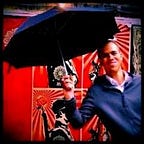Tracking impact in the open air: how to capture feedback in public spaces
In our experiment to use space to bring together people to develop projects to help tackle the climate crisis, we’re thinking about how we track impact and feedback.
Throughout my time helping curate festivals, I’ve tried to track the impact of the activities we’ve run or supported others to do and I’ve learnt that you need to engage people’s different senses, what they see, hear, touch or feel. It started by the impact each sense has on each other.
We feel what we see
We feel emotion when we see something that touches us, be it a child being born. When I ran festivals, I designed a treasure hunt where people needed to look out for different clues to find out where the treasure was. We’d share a story about something and people would need to look around Brixton Market to find the clue, and once they did they connected with the story. I used several of Candy Chang tools to help capture feedback.
We feel what we do
When we’re taking part in activities or even facilitating them, how does it make us feel? Through festivals I’ve run and through the Think & Do space we want to create connections between people but also between people and the space. Even before asking people what they’ve learnt or what they’re going to do as a result of the activity, finding out how it made them feel helps start a conversation about what they could do next and…what could be improved!
We see what we feel
Sometimes we’ve got a feeling about how an activity went or a space that is easier to visualise than to write or even speak about. Discussing different issues at the same time or trying to connect different ideas can be facilitated by joining the dots visually like the example above. This was from an event I facilitated called Visual Camp where we got people together to visualise complex issues to identify where they could find consensus and what actions they could take as a result? How could we visually illustrate discussions, ideas and connections at the Think & Do space?
We do what we see
A space or a festival can have activities where people speak or where people draw, but if you’re walking past a space, they’ll be even more curious if they see movement. Not just movement of people walking to get a cup of tea or a facilitator waving their hands, but people making and performing. It’s also the type of activity which really shows how people are connecting…physically!
We connect our senses
At one of the festivals, I invited @_auralab and Lucy Wilkinson to bring their magic to capture the feedback from the activities. And they created a map of the senses where people shared their experience of the activities and spaces but through the senses. It was amazing to see the stories and the combinations of the senses too! How could you do this in a singular space?
What I’ve learnt from using creative ways to capture feedback is to:
- Help people advocate: Give people the opportunity to be heard and tell their story
- Uncover the unseen: Reveal underlying issues and topics
- Value feeling as well as need: collect emotional, sensory and experiential data and take it as seriously as facts and figures
- Stimulate new ideas and behaviours: encourage deeper interaction with spaces
- Design empathetic spaces: Think about what conditions would encourage people to share and interact in the spaces they use everyday
